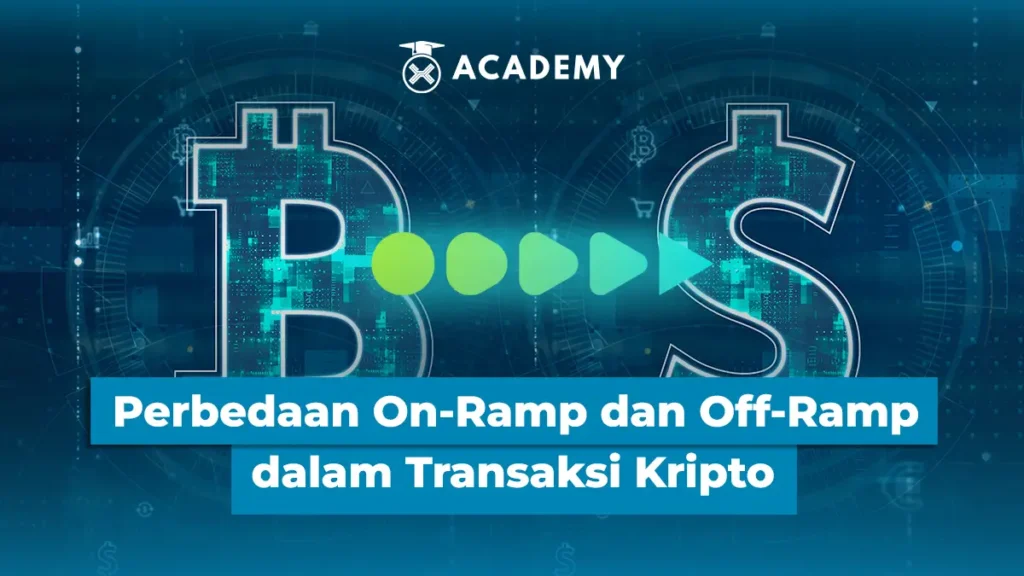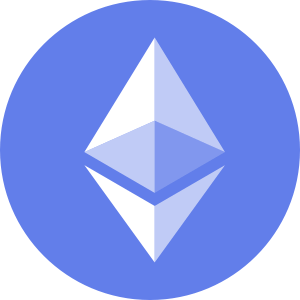Imagine a toll road with two main lanes: an on-ramp for entry and an off-ramp for exit. This simple concept is similar to how the crypto ecosystem works.
In this case, fiat money “enters” the digital asset world through the on-ramp, and then “exits” back into the real financial system through the off-ramp. These two lanes serve as the main gateways that allow anyone to participate in transactions in the crypto world.
But the question is, without these lanes, can crypto truly be used in real life?
What Is an On-Ramp in Crypto?

An on-ramp is the process of converting fiat currency, such as Rupiah, into digital assets like Bitcoin or Ethereum. This term describes the primary entry point for anyone wishing to start trading in the crypto world.
The most common form of on-ramp can be seen in various ways. One is purchasing crypto through an exchange like Indodax, where users can directly exchange their Rupiah balance for their chosen digital asset.
In addition, on-ramps can also be done through debit or credit card transactions, bank transfers, or e-wallet payments.
There are also third-party services, such as payment gateways, that facilitate a faster and more convenient crypto purchase process.
Interestingly, this is the first stage where regulations and KYC (Know Your Customer) verification are implemented to ensure security, transparency, and compliance with applicable financial regulations.
If an on-ramp is like the entrance, then an off-ramp is the exit.
What Is an Off-Ramp in Crypto?
An off-ramp is the process of selling crypto assets to convert their value back into fiat currency, such as Rupiah or Dollars. This process serves as an outlet for users who want to liquidate their digital assets into the traditional financial system.
The most common way to off-ramp is to sell crypto on a crypto exchange and then withdraw the proceeds directly to a bank account.
There’s also the option of using a crypto debit card, which allows users to transact or withdraw cash from their digital asset balance.
Another popular option is through a peer-to-peer (P2P) marketplace, where users can sell crypto directly to other buyers using an agreed-upon payment method.
The primary function of an off-ramp is to provide a secure outlet for investors and help build trust in the crypto ecosystem.
With a transparent and accessible off-ramp system, users can be more confident that their digital assets actually have value and can be used in the real world.
Now that we know the two approaches, let’s discuss their fundamental differences.
The Difference Between On-Ramp and Off-Ramp
The main difference between on-ramps and off-ramps lies in the direction of funds and user goals. An on-ramp occurs when fiat currency, such as Rupiah, enters the crypto world to purchase digital assets like Bitcoin or Ethereum.
Conversely, an off-ramp is the opposite, when crypto assets are sold and converted back into fiat currency that can be used in real life.
In terms of purpose, on-ramps are used to enter the crypto ecosystem, serving as the first step for users who want to invest or transact using digital assets.
Meanwhile, off-ramps serve as an exit, a place where users can cash out their investment returns and enjoy profits in fiat currency.
Both have their own risks and challenges. In the on-ramp process, users are required to pass KYC (Know Your Customer) and comply with applicable financial regulations to ensure transaction security and compliance.
On the other hand, with off-ramps, the greatest risk usually arises from the volatility of crypto prices, which can change at any time during the conversion process.
For example, a new user buys Bitcoin on Indodax using their Rupiah balance—this is the on-ramp process.
After some time, when the Bitcoin price rises and they want to cash out their profits, they sell the Bitcoin and withdraw the proceeds to their personal bank account—this is the off-ramp process.
The Role of On-Ramps and Off-Ramps in the Crypto Ecosystem
Essentially, on-ramps and off-ramps can be described as “gateways” in and out of the crypto world.
Both play a vital role in driving mass adoption because without these channels, digital assets would not be able to interact directly with the conventional financial system.
In terms of market liquidity, the more on-ramps available, the greater the potential for fiat funds to flow into the crypto ecosystem.
This makes the market more vibrant, increases trading volume, and opens up opportunities for new investors to participate. Meanwhile, off-ramps play a crucial role in building user trust.
With a clear path to withdraw funds back to their bank accounts, users feel more secure knowing that their crypto assets can be converted into real money at any time.
This makes crypto not just a speculative instrument, but also an easily accessible part of the financial system. Furthermore, local regulations ensure that both channels operate safely and transparently.
In Indonesia, for example, oversight by the Financial Services Authority (OJK) ensures that crypto exchanges operate in accordance with applicable permits and regulations, ensuring that user transactions remain protected within clear legal boundaries.
Without these two channels, crypto would simply be a hidden asset—not a real medium of exchange.
Real-World Implementation Example

In practice, the concepts of on-ramps and off-ramps are already present in various financial services connected to the crypto world.
In Indonesia, crypto exchange platforms are a concrete example of providing these two channels simultaneously. Through the deposit feature, which acts as an on-ramp, users can exchange Rupiah for digital assets like Bitcoin or Ethereum.
Meanwhile, through withdrawals, the off-ramp process allows these assets to be converted back into fiat and withdrawn to a bank account.
Globally, crypto debit cards like the Binance Card or Coinbase Card also demonstrate how digital assets can be used directly in everyday transactions.
These cards automatically convert crypto balances to local currency when payments are made, bridging the use of digital assets in the real world without complicated manual processes.
Furthermore, the integration between fintech and banking is further strengthening the crypto ecosystem.
Several financial services are starting to open payment channels for digital assets, whether through bank transfers, e-wallets, or payment gateways connected to crypto platforms.
Essentially, these innovations create a faster, safer, and more efficient transaction experience for users.
Now, from these examples, there is another important thing to note: security.
Security and Regulation
Security is the most crucial aspect of the on-ramp and off-ramp processes because this is where user funds move from the traditional to the digital world, and vice versa.
At the on-ramp stage, protection begins with the implementation of Know Your Customer (KYC) and Anti-Money Laundering (AML) procedures.
These two procedures ensure that every user purchasing crypto has a clear and verified identity, thus minimizing the risk of financial crime from the outset.
In Indonesia, the Financial Services Authority (OJK) requires all regulated exchanges to implement KYC and transparently record transaction activity as part of its oversight of digital asset trading.
At the off-ramp stage, the focus of security shifts to users’ wallets and bank accounts.
The process of withdrawing funds from crypto assets to fiat currencies involves integrating payment and banking systems, which must have strong encryption and comply with financial security standards.
Mastercard’s 2024 report noted that collaboration with crypto platforms, including its partnership with Paxos through its Global Dollar Network, enhances security and accelerates conversions between fiat and digital assets.
However, the main threats come from unofficial channels, such as fake exchange websites, P2P transactions without escrow (funds are temporarily held to ensure transaction security), and fake investment offers that often result in fraud.
Conclusion: Two Channels That Keep the Ecosystem Alive
So, that was an interesting discussion about on-ramps and off-ramps, the channels through which money flows into and out of crypto. You can read more about this in the INDODAX Academy Crypto Academy.
In conclusion, on-ramps and off-ramps are the two main channels that keep the crypto ecosystem flowing.
On-ramps serve as an inflow for fiat funds into digital assets, while off-ramps serve as an outflow, allowing users to cash out their assets back into real currency.
Before starting to trade, understanding the roles of both is crucial for safe and efficient transactions.
Without on-ramps, crypto cannot grow. Without off-ramps, users cannot trust them.
By the way, in addition to gaining in-depth insights through various popular crypto education articles, you can also broaden your horizons through a collection of tutorials and choose from a variety of popular articles that suit your interests.
Besides updating your knowledge, you can also directly monitor digital asset prices on Indodax Market and stay up-to-date with the latest crypto news. For a more personalized trading experience, explore Indodax’s OTC trading service. Don’t forget to activate notifications so you don’t miss out on important information about blockchain, crypto assets, and other trading opportunities.
You can also follow our latest news via Google News for faster and more reliable access to information. For an easy and secure trading experience, download the best crypto app from INDODAX on the App Store or Google Play Store.
Maximize your crypto assets with the INDODAX Earn feature, a practical way to earn passive income from your stored assets. Register now with INDODAX and easily complete KYC to start trading crypto more safely, conveniently, and reliably!
Indodax Official Contact
Customer Service Number: (021) 5065 8888 | Support Email: [email protected]
Also follow us on social media here: Instagram, X, Youtube & Telegram
FAQ
1.What are on-ramps and off-ramps in crypto?
On-ramps are the process of buying crypto with fiat currency, while off-ramps are the process of selling crypto for fiat currency.
2.Are on-ramps and off-ramps only available on exchanges?
Not always. They can also be accessed through fintech, P2P marketplaces, or crypto debit cards.
3.Why are on-ramps and off-ramps important for crypto adoption?
Because they form a bridge between the traditional financial system and the digital ecosystem.
4.Is the on-ramp process in Indonesia supervised by regulators?
Yes, all regulated exchanges in Indonesia are supervised by the Financial Services Authority (OJK).
Author: Boy





 Polkadot 8.95%
Polkadot 8.95%
 BNB 0.79%
BNB 0.79%
 Solana 4.78%
Solana 4.78%
 Ethereum 2.37%
Ethereum 2.37%
 Cardano 1.53%
Cardano 1.53%
 Polygon Ecosystem Token 2.11%
Polygon Ecosystem Token 2.11%
 Tron 2.85%
Tron 2.85%
 Market
Market


